Cornerstone Contributions: In Other News … Stories from the Daily Times, October 23, 1887

Event organizers included several newspapers featuring stories related to the dedication of the cornerstone in the Lee Monument’s cornerstone box. One such paper, listed in an inventory of the cornerstone box, was the October 23, 1887, issue of the Daily Times. One half-page article of the eight-page paper discussed the upcoming dedication of the Lee Monument’s cornerstone. By exploring the other seven-and-a-half pages of the paper, a light can be shined on trends and oddities of local, state, and national politics and culture.
The Daily Times
The Civil War caused a huge demand for information across the nation. Even after the war ended, demand remained high, and cities all over the U.S. saw an explosion of new publications. High circulation numbers also led to political influence and large profits for publishers, encouraging even more opportunistic entrepreneurs into the business. As Virginia’s capital, Richmond was an especially rich newspaper market. Post-war demand resulted in the Daily Times being one of more than twenty papers published in the city by 1887.[1]

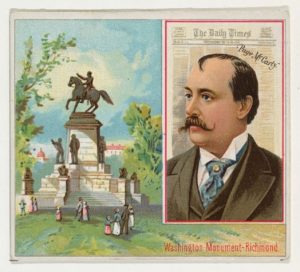
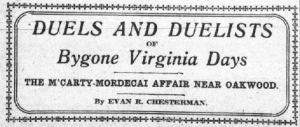
The Daily Times’ publisher in 1887, W. Page McCarty, was well known in his own right. Born to a prominent Virginia family, McCarty studied law at UVA and fought in the Confederate Army. Following the war, McCarty entered Richmond’s newspaper industry. In 1873, McCarty and former friend and classmate John Mordecai competed for the attention of one of the city’s most eligible bachelorettes, Mary Tripplett. Following a possible snub at a local dance, McCarty published a poem rebuffing Mary’s enchantments. When Mordecai confronted McCarty about the poem at a local club, the two came to blows. In response, McCarty challenged Mordecai to a duel, which his friend-turned-enemy readily accepted. The two met at Oakwood Cemetery on May 9, 1873. Exchanging revolver shots at a dozen paces, Mordecai fell mortally wounded, while McCarty received a crippling wound to the leg. Authorities charged McCarty with first-degree murder, but he ultimately limped away with only an involuntary manslaughter conviction, a $500 fine, and a stained reputation. The 1870s and 1880s were the last gasps for dueling in Virginia, with the McCarty-Mordecai affair the final deadly duel in Richmond.[3]
Politics and Memory
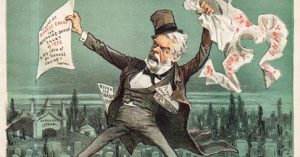
By examining the Daily Times’ stories involving politics and race, one can better understand the cultural environment in which the Lee cornerstone was dedicated. The paper’s articles discussing the dedication of the cornerstone focus on Lee’s character or the decorations planned for the city. To create the appearance of bipartisanship, supporters avoided negative language related to politics or race. However, the memory of the war remained fresh in white conservative elites’ minds, the same people planning the upcoming festivities. This can be seen through the Daily Times’ report on a Henrico Co. Democratic Party meeting, at which speaker Col. R.F. Beirne announced, “Our foe is the same one that we have had to confront ever since the war. There are many people who have forgotten the injuries done us by the Radical party … It is the party which has kept alive the war feeling and persisted in stirring up strife and bitterness in the North in order to perpetuate its power.” Accusing his opponents of ‘waving the bloody shirt’ and provoking war-era partisan resentment, Beirne does just that by invoking martial language and playing the victim card himself.
In addition, the atmosphere of racial terror that marked the period can be observed by reading a small report buried on page 4 of the paper. The article describes, “Tom Wilson, the colored man who killed Jim Davis in Henry county Saturday night, was captured by the officers in pursuit near Mayo Forge, in Patrick county, Monday night, and brought back to Martinsville. Some threats of lynching were made, but nothing in that direction was or will be done.” It is unclear what ultimately happened to Tom Wilson, but it underlines the deadly reality of everyday life for African Americans at the time. James Madison University’s Racial Terror: Lynching in Virginia project identifies 84 black people lynched in Virginia between 1877 and 1927, likely an undercount of the true number.[4]
These two articles highlight the undercurrent of partisan politics and racial violence that defined the period in which the Lee monument was installed. However, a parallel, contradictory movement was also at play, that of sectional reconciliation. Evidence of reconciliationist ideas can be observed in the Daily Times through Rev. Thomas De Witt Talmage’s “Forgiveness before Sundown” sermon, given at the Brooklyn Tabernacle and reprinted on page 3 of the paper. Talmage, a popular evangelical preacher, discussed the spiritual importance of “not to let the sun go down on our wrath, because we will sleep better if we are at peace with everybody.” While not directly invoking the Civil War, many people would have naturally made the connection between Talmage’s sermon and the cataclysmic destruction that engulfed the country only a short eight years in the past. The period of Confederate commemoration, which the erection of the Lee monument helped kick into high gear, was defined by these contradictory ideas of sectional reconciliation on one hand, and racial and political partisanship on the other.[5]
Local Color
While the Daily Times featured stories covering national and world news, the paper dedicated most of its columns to issues of local and state interest. Many of these local stories would be familiar to readers if printed today. The front page featured a story about wayward youths entitled, “The Gravel Shooter Nuisance,” going on to describe, “complaints have been made to the First police station that boys with gravel shooters would break the glass in the Public School building on the corner of Marshall and Nineteenth streets.” Replace gravel with paintballs or airsoft guns, and this story could be seen on the 11:00pm nightly news.
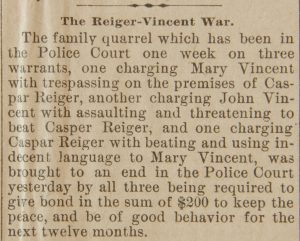
A local feud was also featured, which the paper called, “The Reiger-Vincent War.” Invoking imagery of the Hatfields and McCoys, who were at the time murdering each other over the border in West Virginia, the article describes, “The family quarrel which has been in the Police Court one week on three warrants, one charging Mary Vincent with trespassing on the premises of Caspar Reiger, another charging John Vincent with assaulting and threatening to beat Caspar Reiger, and one charging Caspar Reiger with beating and using indecent language to Mary Vincent.” The court forced all three to put up a substantial $200 bond to keep the peace, which appears to have worked, as no evidence can be found in succeeding issues of a Hatfield-McCoy style massacre.
Across the James River in Manchester, still an independent city from Richmond in 1887, the Daily Times reported on a case of animal cruelty; a man accused of beating his horse. However, the court dismissed the charges when it was discovered “that the horse was the master of the man.” One can’t help but smile when trying to envision what exactly this means.
Lastly, a report from Fincastle, VA, mirrored recent episodes of The Bachelor. The paper told the story of a Ms. Jeannie Conise who “eloped with a Mr. Joseph Watkins and was married, while Miss Conise’s affianced husband-to-be was patiently awaiting his prospective bride’s return from a buggy ride with the man she married.” Even reality TV producers could not make up better drama.
Different Times
While many articles invoke relatable modern issues, the paper regularly reminds you that it is in fact from the 1880s. One such story was the
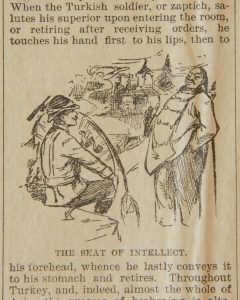
latest installment of the adventures of bicyclist Thomas Stevens, considered the father of bicycle travel.[6] Between 1884 and 1886, Stevens became the first person to circumnavigate the globe on a bicycle, a penny farthing to be exact. Papers across the country reprinted Stevens’ reports on his adventures. Stevens’ article in the Daily Times discusses his introduction to non-Western customs in the Middle East and China. Typical of a mid-nineteenth century white Westerner, Stevens uses racist, imperialistic language to describe this transition, “As one approaches the more barbarous countries of the east the natives are found expressing themselves in stranger ways, and one begins to realize that he is among alien races.” He goes on to describe how he “suddenly found myself one day among a people who shook their heads when they meant ‘yes,’ and nodded when they meant ‘no.’” These two-wheeled adventure stories became a thing of the past with the advent of motorized transportation a few decades later.
In addition, several advertisements in the Daily Times reflect the popularity of patent medicines. Prior to
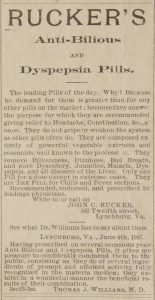
government regulation, these snake oil type remedies became ubiquitous in the late 1800s as they promised to cure just about any ailment a person might have.[7] The Elixir Babek claimed it was an all-natural alternative to quinine for treating malaria. Rucker’s Anti-Bilious and Dyspepsia Pills, manufactured in Lynchburg, VA, promised to “remove Biliousness, Dizziness, Bad Breath, and cure Dysentery, Jaundice, Malaria, Dyspepsia, and all diseases of the Liver.” John Rucker claimed his pills achieved all these wonderful results with only “powerful vegetable extracts and resenoids [sic], well known to the profession.” Unfortunately for many, these claims of all-natural materials and zero side effects did not ring true. Another advertisement in the Daily Times was for Botanic Blood Balm from the Blood Balm Co. of Atlanta, GA. Following early success, inventor Dr. J. P. Dromgoole was forced to sell the company to Coca-Cola owner Asa Candler after the Georgia Supreme Court ruled in favor of a customer-turned-plaintiff that, after ingesting the recommended dosage, reported red spots all over his body, sores in his mouth and throat, and hair loss.[8] Thank goodness for the FDA!
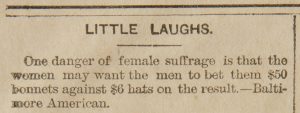
Prior to the popularity of comic strips, papers still realized the importance of entertaining their readers. Instead of comics, the Daily Times included a column dedicated to “Little Jokes” on the last page of the paper. Some of the jokes remain evergreen, including, “He - Did you enjoy the sermon? She - Of course I did. I had on a new hat and dress and the sexton seated me directly in front of that dreadful Miss Briggs.” Others were topical, like one joke that belittled the growing woman’s suffrage movement, “One danger of female suffrage is that the women may want the men to bet them $50 bonnets against $5 hats on the result.” While it would take another 33 years, the suffrage movement ultimately had the last laugh.
Today the Present, Tomorrow the Past
The October 23, 1887, Daily Times contains plenty more interesting stories like the ones recounted above. Next time you read the paper or scroll through your newsfeed, think about what historians 135 years in the future will think about the stories, ads, and oddities you see today.
- Sam Florer
Virginia History Day Coordinator, Virginia Museum of History and Culture
Other posts in the Cornerstone Contributions series may be found in DHR’s archive of Archaeology Blogs.
•••
[1] Lester J. Cappon, Virginia Newspapers 1821-1935: A Bibliography with Historical Introduction and Notes (New York: D. Appleton-Century Co., for the Institute for Research in the Social Sciences, UVA, 1936), 164-194.
[2] James M. Lindgren, "Joseph Bryan (1845–1908)," Dictionary of Virginia Biography, Library of Virginia, published 2001, rev. 2018, https://www.lva.virginia.gov/public/dvb/bio.php?b=Bryan_Joseph_1845-1908, accessed 3/29/2022.
[3] Jean L. Cooper and Brendan P. Fox, A Challenge Was Given: The Duels of John Mason McCarty and William Page McCarty (Palmyra, VA: Shortwood Press, 2017), 36-52.
[4] “Research Process,” Racial Terror: Lynching in Virginia, James Madison University, accessed March 30, 2022, https://sites.lib.jmu.edu/valynchings/research-process/.
[5] For more on these concepts, see Caroline E. Janney, Remembering the Civil War: Reunion and the Limits of Reconciliation (Chapel Hill, NC: University of North Carolina Press, 2013) and David W. Blight, Race and Reunion: The Civil War in American Memory (Cambridge, MA: Harvard University Press, 2001).
[6] Gabrielle Porter and Tom Taylor, "The Impractical Scheme of a Visionary: Thomas Stevens and the Quest to Travel Round the World on a Bicycle," World History Connected, June 2013, https://worldhistoryconnected.press.uillinois.edu/10.2/forum_porter.html.
[7] “Balm of America: Patent Medicine Collection,” Smithsonian National Museum of American History, accessed March 30, 2022, https://americanhistory.si.edu/collections/object-groups/balm-of-america-patent-medicine-collection/history.
[8] Mark Pendergrast, For God, Country, and Coca-Cola: The Definitive History of the Great American Soft Drink and the Company That Makes It (New York: Basic Books, 1993), 52.










